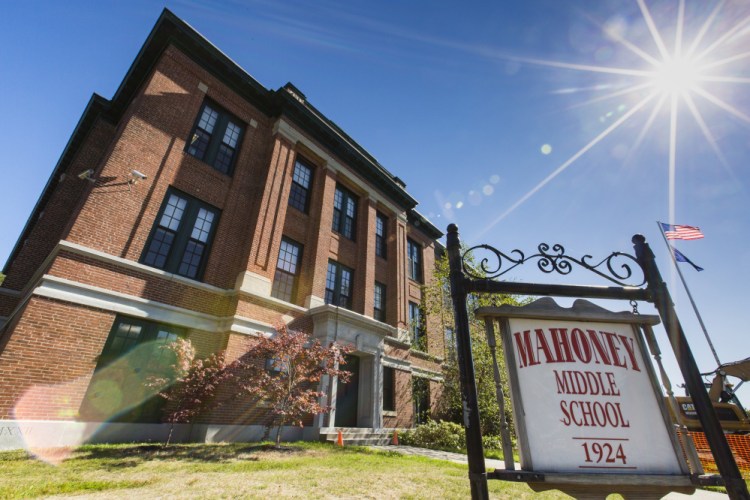SOUTH PORTLAND — As the rumor mill grinds over the potential site of a new, state-funded middle school, the city’s elementary schools are getting extra attention from officials developing a project proposal for the Maine Department of Education.
The school district is considering the possibility of building a new, consolidated middle school to satisfy state officials who want to address building deficiencies throughout the district, not just at the city’s two aging middle schools.
One scenario for a consolidated middle school would add fifth-graders to the current grade 6-8 middle school configuration, which would free up space in the city’s five elementary schools for additional pre-kindergarten classes and special education programs.
WBRC Architects-Engineers, the firm working on the project, has just begun reviewing possible sites for a new or renovated middle school, including the current locations of Mahoney Middle School and Memorial Middle School. WBRC also is finishing a building analysis to help determine whether the state money will be used to renovate Mahoney or build a new, consolidated middle school.
“The state is looking for districtwide solutions,” said Michael Johanning, a senior architect at WBRC. “Then we’re not just fixing one building, we’re fixing many buildings.”
School officials won’t say which sites are being considered because the review is in the information-gathering stage. However, there aren’t that many 10- to 25-acre vacant properties in the city, and the district recently went through a similar search before renovating and expanding South Portland High School, a locally funded project that cost $47.3 million.
One of several sites that were considered for the high school project, and one that is being talked about now, is a 72-acre parcel off Highland Avenue, near the high school, that’s owned by the Portland Pipe Line Corp. Relations between the city and the company have been strained in recent years since the passage of the Clear Skies ordinance in 2015 and the company’s ongoing federal lawsuit to overturn it.
“Everybody’s trying to figure out where a new middle school could be built and everybody knows about that property,” said Dick Matthews, school board chairman.
School officials say they’re also aware of existing concern in the community about whether a consolidated middle school would be built on the east or west side of the city.
Mahoney serves about 325 students and sits on 15 acres at Ocean Street and Broadway, near Mill Creek Park, on the east side. Memorial serves about 400 students and sits on 17 acres at 120 Wescott Road, in the Thornton Heights neighborhood, on the west side.
State funding is available to renovate Mahoney, build a new school for Mahoney students or build a new, consolidated middle school for an estimated $23 million, Johanning said. It’s unlikely that Mahoney’s site could accommodate a consolidated school. Memorial’s site could accommodate a consolidated school but isn’t considered ideal because it’s not centrally located.
And while Mahoney is architecturally striking and historically important, both buildings have significant structural, health, safety and handicapped-access deficiencies, along with asbestos throughout and inadequate heating, ventilation, plumbing, electrical and communication systems.
City taxpayers would have to foot the bill to renovate Memorial, build a new school for Memorial students, or include any features in a middle school that are beyond state guidelines, such as larger classrooms or green enhancements.
The district still has more than a dozen steps to go through before the state would put the project out to bond as early as 2020, said Assistant Superintendent Kathy Germani. The district will hold public forums to figure out whether to renovate or build a new school, then develop a concept, hold a community straw vote and seek approval from the State Board of Education before holding a citywide referendum on the chosen design.
In the meantime, Superintendent Ken Kunin and other district officials are visiting the elementary schools, gathering information about their current condition and use and anticipating changing needs in the future. All were renovated or rebuilt between 2001 and 2005, Germani said, but educational needs and district goals have changed in the past decade.
“(State officials) want us to have all of our documentation, all of it very well done, before we go to the State Board of Education for approval,” Germani said. “They don’t tell you where to put your school. It’s about trying to figure out your space needs. It looks at the district as a whole. In the end, our concern is putting forward a project that best meets the needs of our kids.”
Kelley Bouchard can be contacted at:
kbouchard@pressherald.com
Send questions/comments to the editors.




Comments are no longer available on this story